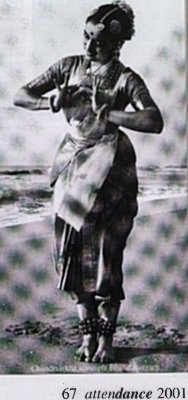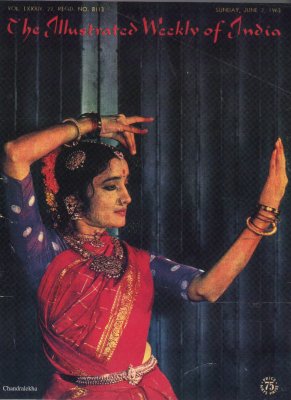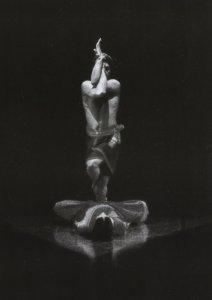 |
  |
 |
  |
Chandralekha - Ashish Mohan Khokar, Bangalore e-mail: khokar@vsnl.net January 6, 2007 Chandralekha was really born in 1984. This was because before that there was Chandra the ordinary Bharatanatyam dancer -- one amongst the crowd and not so distinguished in the solo Bharatanatyam art-form -- but after 1984, there was Chandra the extraordinary choreographer, who won acclaim and was catapulted centre-stage. Although, earlier she had choreographed "Devadasi" in 1960 and Navagraha (with Kamadeva), it was in 1984, thanks to a German Indophile Georg Lechner's initiative that many dancers, including Chandra, got a fresh lease of life as choreographers. Nearly all were post Uday Shankar mould. Lechner was also an ex-husband of Mumbaikar Sonal Mansingh, and he was then posted as director of the Max Muller Bhavan in Bombay. He hosted the first East West Encounter in Bombay, oops, Mumbai. That proved to be a respirator for many senior dancers whose career as a soloist was nearly over and this event gave them a platform to further their art through group works. Their medium remained their chosen idiom, Kathak for Kumudini Lakhia and Bharatanatyam for Chandra, yet the two got a booster shot of sorts and their careers as choreographers got centre-stage. While Kathak had seen Birju Maharaj create group choreographic works, these were still tradition or mythology bound.   Chandra trained under traditional Bharatanatyam gurus like Ellappa of Kanchipuram and for first two decades of her life, tried to dance pure Bharatanatyam. This is important to know because the other two decades were spent in almost decrying and demystifying the same form she had trained in! This is an interesting turn in dance history: she spent half her life learning and the other half, unlearning! But for all posturing, she still used the same positions, stances and format as in Bharatanatyam grammar and just replaced solo dance with group work. After this too became stale, she added kalari and yogic poses, but as supplements. Mumbai gave Chandra and Kumudini a fresh lease of dance career as choreographers. Let us not forget that Mumbai much before 1984 was already exposed to avant-garde dance culture through the work of (Asha) Uttara Coorlawala, a pioneering Parsee gal who later migrated to USA and was thus slowly forgotten. But inspired by her, another Parsee, Astad Deboo, from Jamshedpur, resettled in Mumbai and took to the avant-garde style. So, what was Chandralekha all about and how was she different? Chandra had a slow career in classical Bharatanatyam margam mould and so this 1984 Encounter, gave her a good chance to reinvent and reposition herself and her art. She was ably supported, aided and abetted by divas, designers and doers of dance. Chandra also made anti-tradition noises and thus dyed her hair white (or bleached it) to prove all dancing damsels were not black-haired with kajal-rimmed eyes, as described in traditional literature or repertoire. A new moon indeed arrived on the dance scene. History offers us an interesting vantage point to view how time and nature conspire to help: the mid-eighties were times of the grand Festivals of India abroad and Chandra got opportunities to create and choreograph for major Openings, like the one in Moscow, in the presence of Gorbachev and Rajiv Gandhi. For someone who projected an anti-establishment voice, she got maximum support from the establishment! Either she was good or her agents were!   Chandra was and will remain the first one to break the body of Bharatanatyam from being the art of the soloist to becoming a group or ensemble work. Before this, while many group productions abound, chiefly the Kalakshetra variety of mythological dance-dramas and Nataraj-Shakuntala ones, Bharatanatyam had not been so used to quantify a movement. Chandra went ahead and created a neo-classical genre of using 5 performers to do the same allarippu or tillana. Then, for her to have asked of Yamini the great, what purpose her group work served (at the Encounter) seemed a case of the moon asking the sun why it shone so brightly! Chandra (and Kumudini Lakhia) both of Gujarat, took traditional dance form like Bharatanatyam and Kathak and used it to create group choreographies, anew. They thus can be called path-finders, if not pioneers. The test of a good idea is also how many other copycats abound and today when one sees almost everyone who can move a limb or arm copy these two, it means their art reached, impressed and helped mould a generation. Today, this too has suffered and gone a step further when those who cannot do a margam repertoire fully, take to shortcuts and thus adopt postures, when not positioning themselves as Chandra clones. Among her works of lasting consequence are "the Navagrahas," "Angika," "Sri" and "Lilavati." All in the decade 1984-95. Everything later became either soft-porn or a celebration of erotica. She did not take kindly to critics who did not pander to each and every work. Many artistes suffer from this human fraility. Works like "Yantra" and "Sarira," looked forced and forgettable. It was sad to see in 2001, at the second Lechner hosted Germany-focussed event, again in Mumbai, Mumbaikars leaving her "Sarira" midway because they found it obscene. Mumbai made Chandra and Mumbai had had enough. The best of Chandra, with all the projection and promotion, lasted less than two decades. In late nineties and early 2000, attempts at trying to pedestal her as the Pina Bausch of India fell flat as there were too many new choreographers and Chandra did not need crutches, that too imported ones. Had she been compared to an Indian great, it would have served some purpose; to equate and platform as some alien star was unnecessary. Chandra and her "promoters" did not take kindly to criticism when this was pointed out. Chandra was simple at heart and laughed easily. The "packaging" of Chandra's persona did injustice to her nature because she was beyond labels. She rode motorcycles and drank coffee from roadside stalls but her public image was one of cleverly created exclusivity. Pity, because she was a nice person to know, one to one. For this critic, her sthayi bhava was adbhuta! Always, wondering. She did not want followers or shisyas, never created a school (although she made a style) and rarely won any national honours. She sat by her beachside acre of a house lit by Sadanand Menon, a technically gifted writer-editor and old friend, designer Dashrath Patel. Ramana Mahrishi, Jiddu and Hiren Chattopadhya inspired her, not necessarily in that order, though. Chandra was different and created and charted an independent course. She leaves behind no student (except clones), no real legacy (except experimentation), and no discourse (much as feminists saw her as one). Chandra stood alone and it can be lonely at top. From a distance, she shone. Ashish Mohan Khokar is a reputed critic, columnist, author, photographer and dance historian who edits-publishes India's only yearbook on dance, attendance. See attendance-india.com Chandralekha has won numerous awards including the 'Legends of India - Lifetime Achievement Award' (2006), Kalidas Samman (2004), the Sangeet Natak Akademi 'Fellowship' award ('Akademi Ratna'-2005), the Sangeet Natak Akademi award (1992) as well as the International Time-Out/Dance Umbrella award in UK (1991) and the Gaia award for 'cultural ecology' in Italy (1990). |